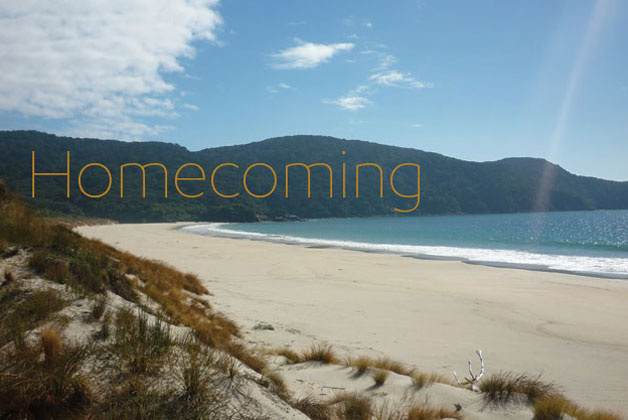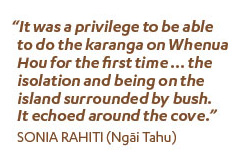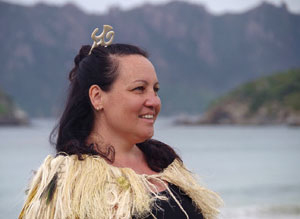Homecoming
Jul 24, 2013


Kaituhituhi Helen Brown sets foot on Whenua Hou.
Photographs Ranui Ngarimu, Helen Brown and Malcolm Rutherford.
Ko Whenua Hou te motu
Ko Waikoropūpū te whanga
Ko Puke Hou te maunga
Ko Waituna te awa
Ko Te Ara a Kiwa te moana
Ko Waitaha, Ngāti Māmoe, Ngāi Tahu ngā iwi
Kei Ngāi Tahu Whānui
Te ihi, te wehi, te mana, te tapu
Tihei mauri ora!
Once upon a time there was a sea captain who sailed to the bottom of the world in search of adventure and good fortune. He conquered treacherous seas to eventually make landfall on a remote but beautiful place on the southern coastline of Te Wai Pounamu. The local Ngāi Tahu people looked upon this stranger with suspicion, but after a time, his seal fishing prowess earned him a degree of good favour, leading one of the chiefs to bestow upon him his daughter’s hand in marriage. The captain and the Ngāi Tahu princess were married and lived happily on an island set apart for them with golden sands and bounteous waters – Whenua Hou – Codfish Island.

Freya Wharerimu Hargreaves-Brown on the Waikoropūpū beach, Whenua Hou.
Whenua Hou loomed large in my childhood mythology. It was a Treasure Island-style backdrop against which a folkloric version of my actual whakapapa played out, the key characters being a ‘captain’ and a ‘Ngāi Tahu princess’.
The fairytale was not entirely devoid of truth. My tipuna Robert Brown was indeed a captain (of the Glory) and his partner Te Wharerimu (Te Atawhuia) was the daughter of the rangatira Tapui and Pitoetoe. The couple lived together on Whenua Hou from the early 1820s as part of the Sealers Bay community, which is widely acknow-ledged as the first permanent mixed Māori and European settlement in southern New Zealand.
Whenua Hou lies to the north-west of Rakiura and is traditionally important as a stopping off point for muttonbirders travelling south to the Tītī Islands. Its rich natural resources and microclimate have lent it to intermittent permanent and seasonal occupation since the 13th century. It is also an important spiritual and cultural place for Ngāi Tahu. For as long as I can remember, I wanted to visit this place.
Sealers worked the coastline of Te Wai Pounamu from the late 18th century until the 1830s when seal populations had been so depleted that the industry was no longer economically viable. Sealing gangs were regularly dropped off along the coast for periods ranging from a few months to several years.
Relations between Ngāi Tahu and sealers were not always amicable, and a number of violent encounters are recorded in our histories. But Ngāi Tahu also knew there was much to be gained from controlled engagement with newcomers in terms of strategic relationships, trade, and access to resources.
By 1824, sealers had been making intermittent use of Whenua Hou for over a decade. Honekai, a leading Ngāi Tahu rangatira in Te Ara a Kiwa (Foveaux Strait region), designated the island as a permanent settlement site for sealers and their Ngāi Tahu wives, thus making it “whenua hou” — a “new land”. This arrangement enabled Ngāi Tahu to maintain the benefits of contact with the resident Pākehā, whilst keeping them at a distance from their own communities where they were frequently a disruptive presence, prone to uncouth behavior, drinking and violence.
Whether forged out of strategy, novelty, or love, the true nature of the relationships between the Ngāi Tahu women and Pākehā sealers on Whenua Hou remains ambiguous. Some of the liaisons were short-lived; others more enduring. My tīpuna Te Wharerimu raised five children on Whenua Hou before her Captain’s untimely death, possibly by drowning, around 1840.
Many Ngāi Tahu whānau are able to trace their ancestry to these early unions on Whenua Hou, so the island plays an extremely significant role in the iwi’s contemporary whakapapa. The strength of these whakapapa connections was profoundly evident during a series of hīkoi (journeys) held last year. These hīkoi sought to build cultural capacity among Whenua Hou descendants and reconnect them with their tūrangawaewae. I had the privilege and good fortune to undertake this journey — as a participant and later as a kaiārahi (guide).
“Take my ashes to Whenua Hou when I die because that’s the only way I’m going to get there!’” Ranui Ngarimu (Ngāi Tahu, Ngāti Mutunga) recalls telling her whānau.
As a Whenua Hou descendant, Ranui had always dreamed of visiting the motu where her tipuna Neke lived with the sealer Daniel “Cranky” Smith in the early 19th century. But as a strictly controlled Nature Reserve and centre for the Department of Conservation’s (DOC) Kākāpō Recovery Programme, a visit to the island “on her own waewae” seemed near impossible.
So, when the opportunity arose to travel to Whenua Hou with other descendants, Ranui regarded it as an important tohu (sign). As a tohunga raranga (master weaver), she was also excited at the prospect of discovering what weaving resources were available on the island. For Ranui, members of my own whānau, and the majority of hīkoi participants, visiting Whenua Hou was the fulfillment of a lifelong dream.
First steps in a new land are always significant, but take on immense meaning when they are also a homecoming. Last March, as our rōpū (the first of three groups scheduled to visit Whenua Hou) stepped down from the helicopter and on to our ancestral whenua for the first time, many were trembling with emotion. Tears were shed – ngā roimata o ngā tīpuna. Tāua Ranui spontaneously did a karanga. In that moment, the key organiser of the trips, Dave Taylor (Ngāi Tahu – Ngāi Te Ruahikihiki), knew he was on the path to helping ngā uri o Whenua Hou re-establish a Ngāi Tahu footprint on the island. Himself a Whenua Hou descendant, Dave both understood and shared the motivation and emotion of the group. “It was the tūrangawaewae connection that brought the descendants on the trips – they were all motivated in the first place by their whakapapa.”

Kā Tapuwae o Kā Wāhine Toa.
For Ngāi Tahu whānui (and Māori katoa) one of the major and persistent impacts of the colonial experience is alienation from our turangawaewae – our ancestral lands. As Ranui puts it, “the places where our tūpuna actually grew up and where their footsteps are, where they stood and the paths that they walked.”
In the case of Whenua Hou, simply making landfall on the beach has required a special permit since 1968. Ngāi Tahu access to the island has been denied to a greater or lesser extent since it was deemed Crown land in 1864.
Tane Davis (Ngāi Tahu) has vivid memories of fishing the coastline around Whenua Hou with his father. “We would go and moor in Sealers Bay for the night and I would look into the beach from the boat and wonder what was there. I can distinctly hear my father saying, ‘Son, we’re not allowed ashore there because it’s a Scenic Reserve’. At that time Whenua Hou was managed by the Department of Lands and Survey and the Wildlife Service and public access was prohibited.”
Later, in the 1990s, Tāne’s mother, Aunty Jane Davis (Ngāi Tahu), was part of the Ngāi Tahu negotiating team that initially sought the return of Whenua Hou as part of Te Kerēme (the Ngāi Tahu Claim). Aunty Jane recalls that any real opportunity for the return of the island was thwarted by the existence of the then recently established Kākāpō Recovery Programme of which the Crown was highly protective. “The kākāpō is our taonga,” says Aunty Jane. “But much as I love the bird, we believe it took priority over us. It was the major block to us getting the island back. We realised how endangered the kākāpō were, but we felt endangered too.”
The first kākāpō were transferred to Whenua Hou in 1987 following an extensive programme of predator eradication. In that context and at that time, Ngāi Tahu had to set aside ownership aspirations and instead seek alternative forms of redress.
Ultimately, the island remained Crown land but the provisions of the Ngāi Tahu Claims Settlement Act 1998 greatly enhanced Ngāi Tahu involvement in its management and use, primarily through Ngāi Tahu representation on the Whenua Hou Committee. The Committee was set up to advise the Conservation Board and Minister on the island’s management.
As a member of that committee since its inception (and as its current Chair), Tane Davis is quick to acknowledge the Ngāi Tahu kaumātua including the late Uncle George Ryan, Hine Maaka, Suzanne Spencer and others who set the groundwork for the DOC/Ngāi Tahu relationship on Whenua Hou today.

Ngā uri o Whenua Hou including descendants of Neke, Popia, Wharerimu, Pura, Wharetutu, Hinetuhawaiki and Te Maka who took part in the Whenua Hou Access Pilot Project 2012
Significantly, the Treaty settlement legislation also provided right of entry (with permit) to all Ngāi Tahu whānui who whakapapa to the island. Despite this provision, very few Whenua Hou descendants have actually set foot on the island in the years post-settlement. Conservation and biodiversity values have tended to take priority. Furthermore, Whenua Hou is an undeniably difficult place to get to – you can’t go online and book a ticket.
Working for DOC in Murihiku, Dave Taylor became increasingly aware of the relative lack of Ngāi Tahu presence on Whenua Hou given its significance to Ngāi Tahu. After organising a permit for his own whānau to make a day trip to the island, he was determined to assist other Ngāi Tahu to visit, and was in a unique position to make this happen. “There are a lot of barriers to visiting the island – just the logistics of transport and permits would frighten most people away – but I thought, ‘That’s not hard for me; I can make that happen quite easily,’. I saw it as a way of contributing and growing capability among our people.”
In addition to assisting whānau to negotiate the logistics involved in getting to the island (including stringent quarantine requirements), Dave was keen to ensure that the hīkoi were also a cultural experience, incorporating a noho marae (marae stay) at Takutai o te Tītī Marae at Colac Bay, and a mihi whakatau (welcome) for whānau arriving on the island. With this in mind, he sought the involvement of Whenua Hou descendants as kaiārahi to accompany and support whānau groups returning “home” to Whenua Hou.
Ron Bull jnr (Kāti Te Ākau), Estelle Leask (Ngāi Tahu, Whakatōhea, Ngāti Ruanui), Sonia Rahiti (Waitaha, Kāti Māmoe, Kāi Tahu) and I rose to the challenge – becoming conversant with the history of the island, and learning about its archaeology, flora, fauna, placenames and whakapapa to share this mātauranga (knowledge) with other descendants visiting the island. For the wāhine, our preparation also included stepping up and learning to karanga.
“It was a privilege to be able to do the karanga on Whenua Hou for the first time,” says Sonia. “That was a really big thing for me – the isolation and being on the island surrounded by bush. It echoed around the cove. That was very special.”
Sonia is a muttonbirder to the core. For her, Whenua Hou’s isolation, beauty and sense of “going back in time” were immediately familiar – akin to her experience of the Tītī Islands.
In total, 37 Whenua Hou descendants were welcomed to the island across three separate hīkoi in March, October, and November last year. The Whenua Hou Access Pilot Project was supported by the Ngāi Tahu Fund, DOC, Ōraka Aparima Rūnaka and the Whenua Hou Committee.
For many of the whānau on the trips, this was their first experience of real engagement with the iwi. As Ranui Ngarimu says, “It’s a beautiful awakening.”

Takutai o Te Tītī provided the perfect departure point for the hīkoi in a cultural and geographical sense, enabling descendants to connect with their whanaunga on the mainland first, before flying in a direct line from the south coast across Te Ara a Kiwa to Whenua Hou.
On the island the whānau walked the beaches, visited the site of the kāika at Waikoropūpū Sealers Bay, took in the stunning views, and simply breathed in the air.
They gathered kai moana, harvested harakeke, wove paraerae (harakeke sandals), made pōhā, tramped around the island, and talked whakapapa into the night. They ate like kings. Tohunga mātauranga shared their wisdom. Kyle Davis (Ngāi Tahu – Ngāi Te Ruahikihiki) saw his first mohua (yellowhead) in the wild; Rosemary Wheeler (Ngāi Tahu) felt a powerful connection to the land and her whanaunga; and Freya Hargreaves-Brown (Ngāi Tahu – Ngāi Te Ruahikihiki) did countless cartwheels.
As a participant on the hīkoi, Kyle reflects that “the mauri of Whenua Hou has to be seen and breathed to be believed.”
DOC technical advisor Rachael Egerton agrees. “You don’t really understand the history of a place until you’ve been there,” she says.
As the instigator of a significant programme of historical and archaeological research on Whenua Hou in recent years, Rachael regards the pilot hīkoi as an important step in reconnecting people with place, and as a potential model for other projects.
“In the past DOC work has focused on physical values, and really they don’t mean anything without the people who hold the values. It’s the non-physical values that connect people to places, and mean that we are able to sustain those places into the future.”

Kaiārahi Estelle Leask (nee Pērā) wearing Kā Tapuwae o Kā Wāhine Toa on Whenua Hou.
Dave goes further, suggesting that in time he would like to see Ngāi Tahu become a strong presence on the island, not only in terms of cultural practice, but also management and conservation work.
Aunty Jane Davis is unequivocal. “As for the future of the island – as any red blooded Ngāi Tahu would think – it should come back to the tribe”.
Science tells us that the harakeke on Whenua Hou is not naturally occurring. Our tīpuna took it there.
During the hīkoi in March, Ranui Ngarimu gathered harakeke from four different sites around Waikoropūpū Sealers Bay where the plant continues to flourish. “Our tūpuna took the right stuff for themselves; good strong fibre.”
When I returned to Whenua Hou as a kaiārahi in November, I brought a very special taonga with me. Kā Tapuwae o Kā Wāhine Toa is a pākē (rain cape) made by Ranui, with some input from me, using materials harvested on the island.
Blessed by Stewart Bull at Takutai o Te Tītī Marae and named by the kaiārahi wāhine (Estelle, Sonia and I), the pākē is a gift to ngā uri o Whenua Hou and is intended to be worn by kaikaranga when they are welcoming manuhiri and manawhenua to the island. The pākē incorporates pīkao, harakeke and feathers from the manu on Whenua Hou including kākāpō, kākā and kākāriki. A garment fit for a Ngāi Tahu princess.